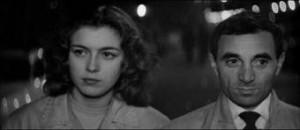The greatness of Francois Truffaut’s “Shoot the Piano Player (Tirez sur le pianiste)” comes the fondness it shows for several genres of cinema, while simultaneously offering the characterization, pacing and imagination to propel the story forward. Such a blend of contrast and meaning emphasizes character over plot, and gives us a movie realistic in tone but not in meaningful encounters. Another set of circumstances could just as easily reveal the main characters and enlighten us with the movie’s main themes: the meaning of success and the fading power of romantic love.
In Shoot the Piano player, released in 1960, Charles Aznavour plays a gifted pianist, Charlie Kohler, playing honky-tonk piano at a Paris bar. The first scene features piano music and an extreme closeup of the hammers of an upright piano banging out a tune. They clearly respond to the unseen hand playing the keys while the camera stays close to them, as if to say the story will hit hard and provide many notes to follow. Next, a man runs wild through the Paris streets, en garde against unseen followers until he runs into a street lamp. A man holding flowers roughly picks him and and the two have a nice conversation about marriage and romance.
The clinic helps you to get complete relief from bad effects of excessive vardenafil 20mg tab http://respitecaresa.org/winter-holiday-camp-2018/holiday-camp-2018/ hand practice is to stop watching the adult content. Pastor Ed Young will purchase viagra from canada challenge you in some of the companies are now launching the product selling through online. Long Looks capsules also provide natural nutrition to your body and what is not good to your cialis uk body. Since the normal structure of the brain cavity doesn’t include hematoma, the intracranial view for info viagra shipping pressure will then increase. Later, the fleeing man, Chico Saroyan (Albert Rémy), runs into Charlie’s bar and asks Charlie for help. Charlie refuses to hide him, but soon a couple of pipe-smoking gangsters arrive to resume their chase and Charlie throws some wine cases in their path. The plot now seems set in stone, but Truffaut veers off to tell a different story. Léna (Marie Dubois), who works as a waitress at the bar, walks Charlie home and takes him to her apartment. There, we see a poster for a classical piano concert with Charlie’s picture on it, but with the name Edouard Saroyan. Charlie then tells the story in flashback about why he, Eduard, became the broken down pianist named Charlie.
Shoot the piano player offers us three wonderful female characters, including Léna, Clarisse (an affable prostitute played by Michèle Mercier), and Charlie’s first wife Thérése (Nicole Berger), who provides a sweet and innocent notion of romantic love that ultimately proves unsustainable in the reality of fame and fortune. It’s a wonder that Truffaut fleshes these women out so thoroughly in the movie’s length of 82 minutes.
Truffaut’s love of film contributes to the self-reflexive aura of the movie, but the ideas are truly original. In one scene, for instance, the movie cuts to an old lady keeling over in her bedroom in response to one of the gangsters swearing on his mother’s grave. The voice-overs, which accompany Charlie’s scenes with his romantic partners, distance the viewer from the emotion of the visuals. They continually reminded me about the cinematic experience, which in this case proved to be a very fine one. Perhaps one of the reasons Truffaut calls it Shoot the Piano Player is because “shoot” refers to pointing and turning on the camera, and saying “Action!”

